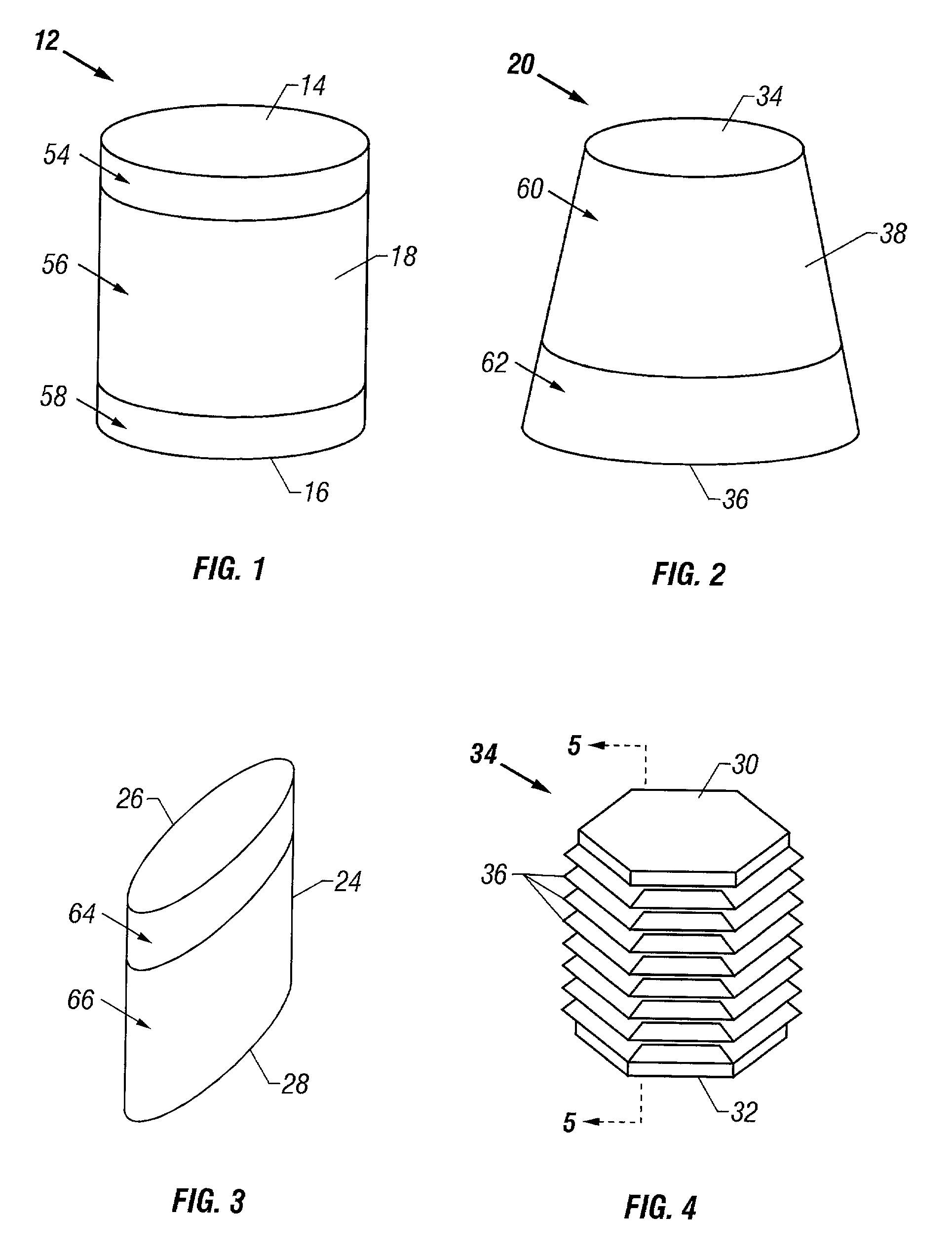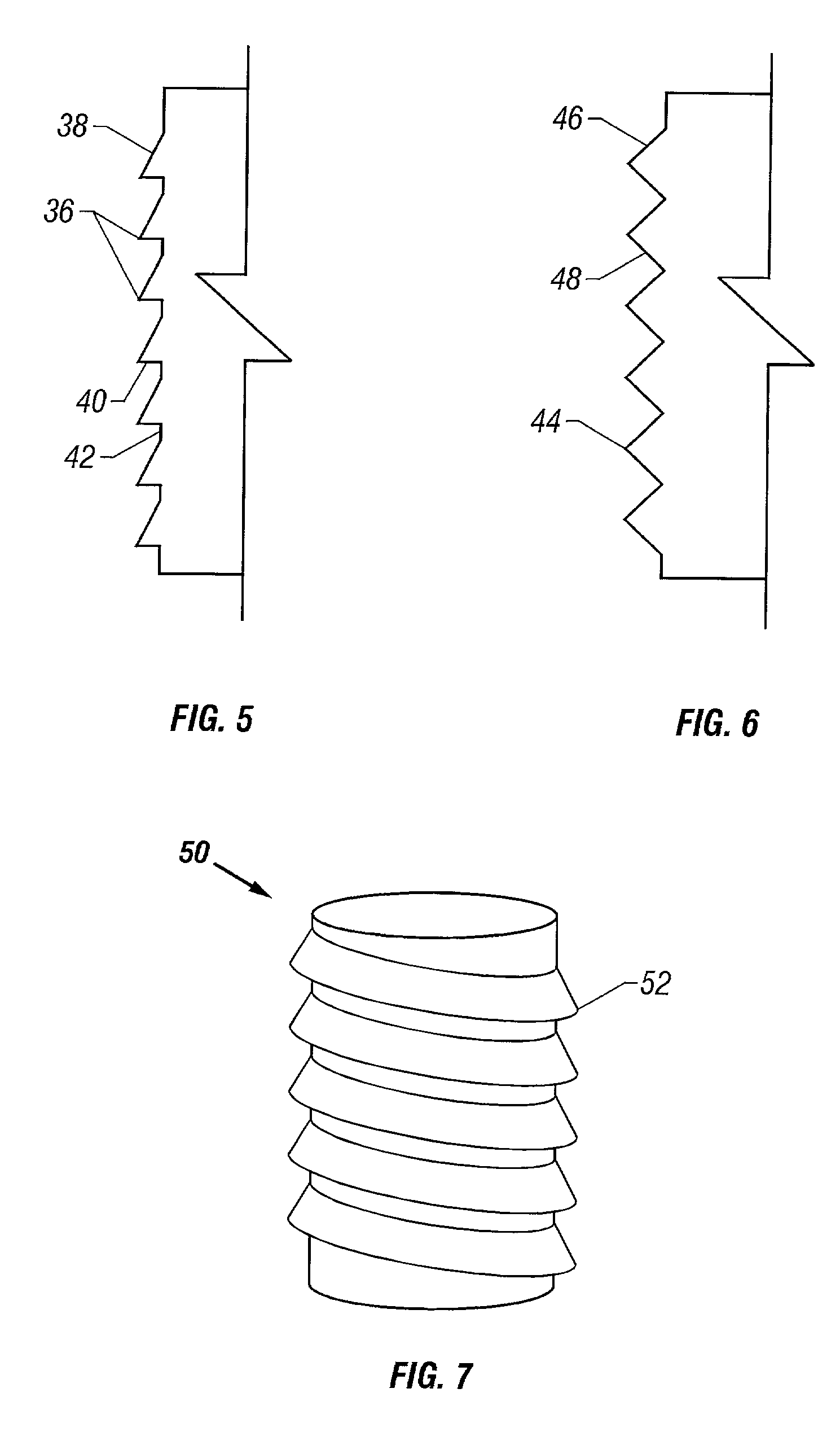Cartilage repair plug
a cartilage repair and plug technology, applied in the field of cartilage repair plugs, can solve the problems of cartilage trauma, deterioration of previously damaged cartilage, and surrounding knees, elbows, shoulders, etc., to improve the anchorability of plugs, prevent them from coming loose, and increase the height-to-diameter ratio
- Summary
- Abstract
- Description
- Claims
- Application Information
AI Technical Summary
Benefits of technology
Problems solved by technology
Method used
Image
Examples
example 2
[0156] The cartilage plugs of the present invention may alternatively be used to anchor a flowable polymer to the subchondral bone. An implantation hole for the plug is drilled into the prepared bony base of the articular cartilage defect. Preparation of the bony base of the defect in this context entails the removal of loose tissue debris and exposure and / or surface modification of part or ll of the subchondral bone in the defect area by the surgeon. Using an inserter instrument that holds and drives the plug for implantantion, the base unit is inserted into the bone to a depth of approximately 50-60% of the plug height. The cylindrical devices are seated such that approximately half of the barbs or ridges on the outer surface of the plug engage the bony walls of the tunnel and the remaining half of the plug's external ridges remain exposed. The inserter tool is removed and rearmed with another anchor plug as necessary and the process is repeated. Multiple anchor plugs may be place...
embodiment 212
[0161] FIG. 12 is a bottom plan view of a bridged plug embodiment 212 of the present invention with two anchoring elements 214, 216 extending from a shared upper layer 218. FIG. 13 is a side view of a two-plug embodiment wherein the upper surface of the upper layer 220 has a curved shape while the lower surface 222 is flat. FIG. 14 is a side view of an embodiment wherein both the upper surface 224 as well as lower surface 226 of the upper layer 218a are both curved to cause the two anchoring elements 214, 216 to be angled toward one another. FIG. 15 shows yet another embodiment wherein both the top surface 228 and bottom surface 230 are flat and parallel to one another.
embodiment 232
[0162] FIG. 16 is a bottom plan view of another bridged plug embodiment 232 of the present invention wherein three anchoring elements 234, 236, 238 extend from a shared upper layer 240. FIG. 17 is a side view of a three-plug embodiment wherein the upper surface 242 of the upper layer 240 has a curved shape while the lower surface244 is flat. FIG. 18 is a side view of an embodiment wherein both the upper surface 246 as well as lower surface 248 of the upper layer 240a are both curved to cause the three anchoring elements 234, 236, 238 to be angled toward one another. FIG. 19 shows yet another embodiment wherein both the top surface 250 and bottom surface 252 are flat and parallel to one another.
[0163] FIGS. 20-22 are end views of bridged plug embodiments showing various cross-sectional shapes of the upper layer. The embodiment shown in FIG. 20 has a convex upper surface 254 while the upper surface 256 of embodiment shown in FIG. 21 is flat and the upper surface 258 of the embodiment ...
PUM
| Property | Measurement | Unit |
|---|---|---|
| diameter | aaaaa | aaaaa |
| depth | aaaaa | aaaaa |
| hardnesses | aaaaa | aaaaa |
Abstract
Description
Claims
Application Information
 Login to View More
Login to View More - R&D
- Intellectual Property
- Life Sciences
- Materials
- Tech Scout
- Unparalleled Data Quality
- Higher Quality Content
- 60% Fewer Hallucinations
Browse by: Latest US Patents, China's latest patents, Technical Efficacy Thesaurus, Application Domain, Technology Topic, Popular Technical Reports.
© 2025 PatSnap. All rights reserved.Legal|Privacy policy|Modern Slavery Act Transparency Statement|Sitemap|About US| Contact US: help@patsnap.com



